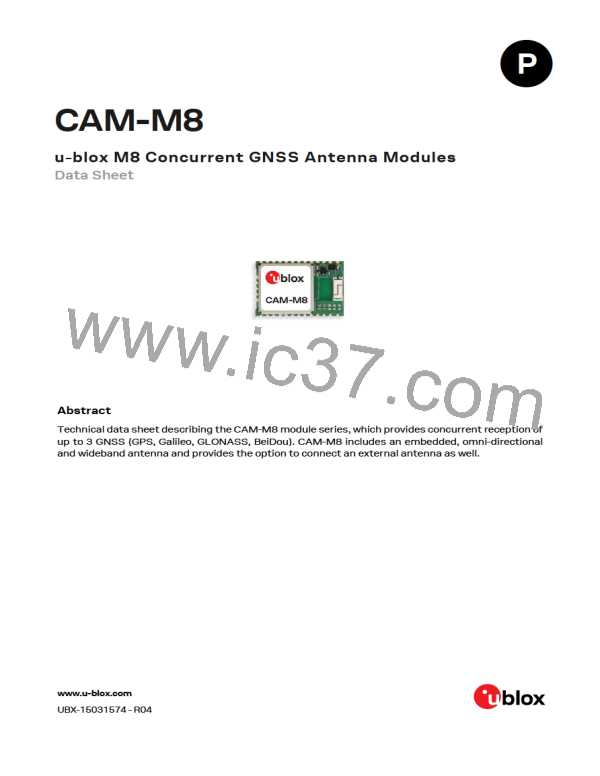CAM-M8 - Data Sheet
1.17 Clock generation
1.17.1 Oscillators
The CAM-M8Q concurrent GNSS module uses a TCXO oscillator. The TCXO option allows accelerated
weak signal acquisition, enabling faster start and reacquisition times.
The CAM-M8C concurrent GNSS module uses a crystal-based oscillator. This makes the CAM-M8C
a more cost efficient solution.
Oscillators used on CAM-M8 series modules are carefully selected and screened for stability and
against frequency perturbations across the full operating range (–40 °C to +85 °C).
The careful selection and qualification of critical parts, such as GNSS oscillators, has resulted in
u-blox modules being the most reliable positioning modules in the industry, particularly in
challenging conditions
1.17.2 Real-Time Clock (RTC)
In the CAM-M8Q the RTC is driven by a 32 kHz oscillator, which makes use of an external RTC crystal.
If the main supply voltage fails and a battery is connected to V_BCKP, parts of the receiver switch
off, but the RTC still runs providing a timing reference for the receiver. This operating mode is called
Hardware Backup Mode, which enables all relevant data to be saved in the backup RAM to allow a hot
or warm start later.
The CAM-M8C has no integrated RTC crystal. The CAM-M8C can operate in single crystal mode,
where the 26 MHz crystal oscillator can be used to provide frequency reference to the RTC without
using an additional RTC crystal in Hardware Backup Mode. This makes the CAM-M8C a more cost
efficient solution at the expense of a higher backup current.
The current time is maintained in the RTC and ephemeris and other last known data is kept in the
backup RAM. In A-GNSS based systems, the RTC is not required when coarse or fine time
information is available from the network.
☞
More information, see the CAM-M8 Hardware Integration Manual [1].
1.18 Power management
The u-blox M8 technology offers a power optimized architecture with built-in autonomous power
saving functions to minimize power consumption at any given time. Furthermore, the receiver can
be used in two operating modes: Continuous mode for best performance or Power Save Mode for
optimized power consumption respectively.
1.18.1 DC-DC converter
The CAM-M8 module integrates a DC-DC converter, allowing reduced power consumption especially
when using a main supply voltage above 2.5 V.
☞
For more information, see the CAM-M8 Hardware Integration Manual [1].
UBX-15031574 - R04
Production Information
Page 14 of 31

 U-BLOX [ u-blox AG ]
U-BLOX [ u-blox AG ]